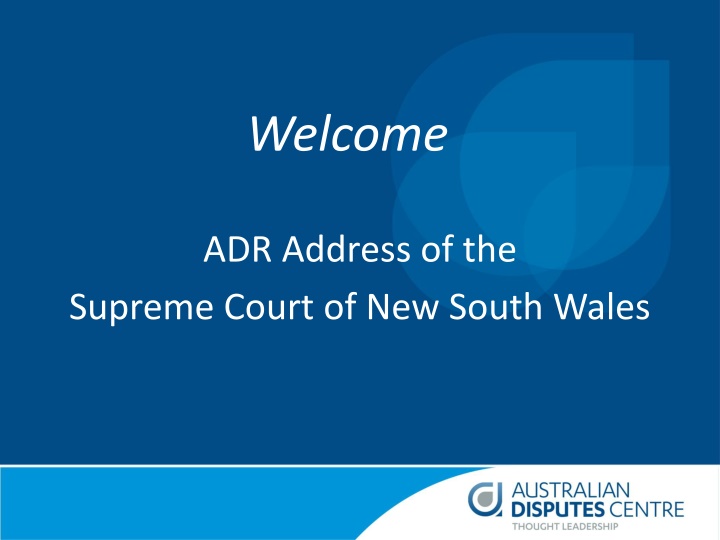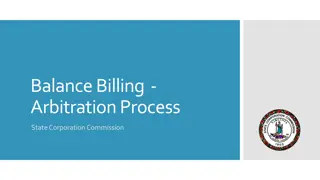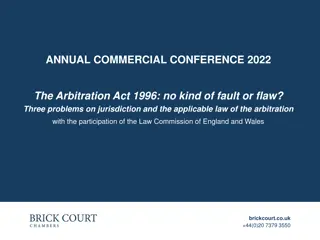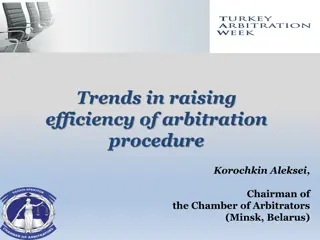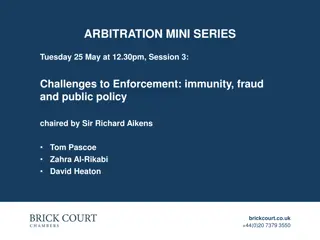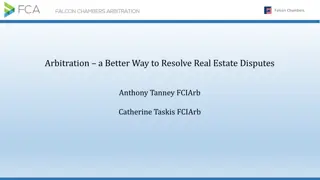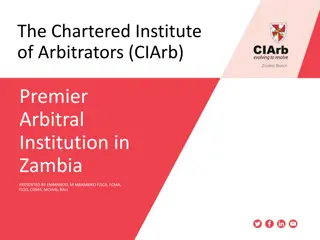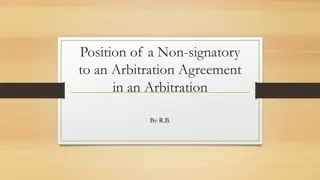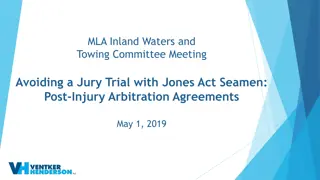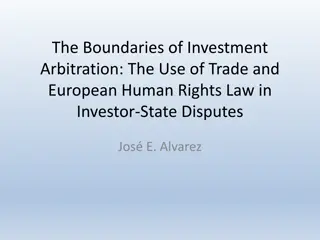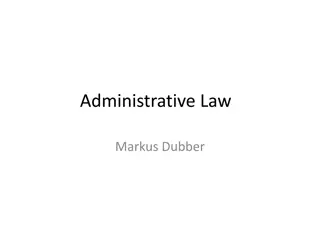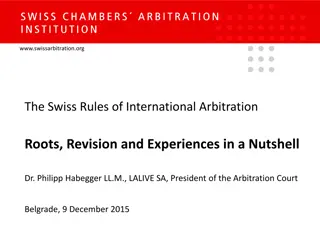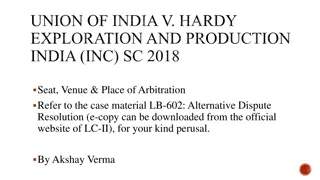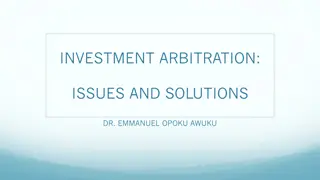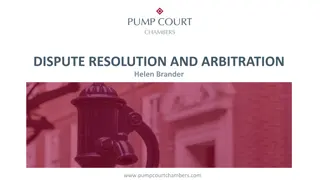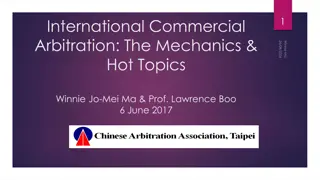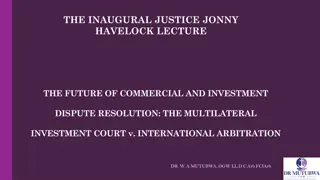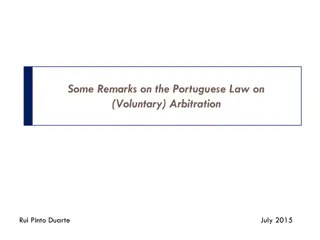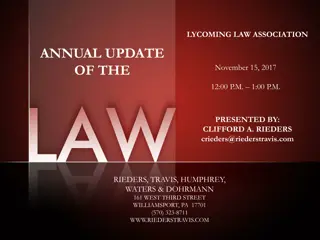Evolution of International Arbitration: Trends and Challenges
The evolution of international arbitration has seen a significant rise in cases over the years, with a focus on the interface between international law and international commercial arbitration. Key aspects explored include the impact of conventions like the New York Convention, the emergence of pro-arbitration case law, and the establishment of dedicated arbitration institutions. The spread of international arbitration across different regions, particularly in Asia, has contributed to the growth and development of this alternative dispute resolution mechanism.
Download Presentation

Please find below an Image/Link to download the presentation.
The content on the website is provided AS IS for your information and personal use only. It may not be sold, licensed, or shared on other websites without obtaining consent from the author.If you encounter any issues during the download, it is possible that the publisher has removed the file from their server.
You are allowed to download the files provided on this website for personal or commercial use, subject to the condition that they are used lawfully. All files are the property of their respective owners.
The content on the website is provided AS IS for your information and personal use only. It may not be sold, licensed, or shared on other websites without obtaining consent from the author.
E N D
Presentation Transcript
Welcome ADR Address of the Supreme Court of New South Wales
ADR Address of the Supreme Court of New South Wales Presented By Prof Luke Nottage PhD, LLD
Cross-fertilisation in International Commercial Arbitration, Investor- State Arbitration & Mediation: The Good, the Bad & the Ugly?
Overview Introduction The Explosion in International Arbitration [ICA then ISA] The Resurgence of Costs and Delays [in both fields of IA] The Fall of Arb-Med [i.e. with same neutral] The Rise of Multi-tiered Dispute Resolution Clauses [different neutrals: e.g. mediation before arbitration] Conclusions
1. Introduction ADR and litigation are part of an overall system For international DR, much discussion on interface or cross- fertilisation between IL & ICA Focus here more on ICA & ISA i.e. foreign investors arbitrating vs host states, usually now under BITs or FTAs with home states (aka ISDS) Plus interface with IM (limited, but pushed also by DM) Arb-Med with same neutral Med-Arb with different neutrals
2. The Explosion in International Arbitration (IA) Underpinned by the 1958 New York Convention Art II stay of litigation: kickstarts the (foreign-seated) IA, i.e. first phase Art V enforcement of awards (with limited exceptions not: error of substantive law): regulates the last phase Australia ratified in 1975 (Singapore 1986) And by the UNCITRAL Model Law (1985, rev d 2006 for interim measures) Drawing on NYC concepts and especially (opt-in) 1976 UNCITRAL Arbitration Rules, to regulate especially the middle phase at ICA seat Australia quite quick to adopt, in 1989 like HK (Singapore 1994), then 2010-17 as core also for domestic arbitrations But still struggles to attract many ICA cases!
Spread East of ICA especially over last 20 years (Reyes & Gu 18): Adopting first NYC, then ML Emergence of pro-arbitration case law e.g. narrowing public policy objection to awards, so deference to arbitrators rulings on procedure: US/UK HK Singapore Australia (in: Ferrari & Rosenfeld eds, Kluwer 23) At least one dedicated IA institution or several, in PRC; cf India (ad hoc arbs) e.g. ACICA from 85 in Melbourne (rebooted in Sydney) SIAC HKIAC, (KLRCA rebooted as) AIAC, KCAB, VIAC Other supportive infrastructure (including university-level & professional training) 2. The Explosion in International Arbitration (IA) cont d
Gradual increase in ISA involving Asian parties More treaties, with full advance consent (e.g. PRC, Thailand) + more FDI = disputes Fewer institutional barriers (e.g. local experts), but not all ratify 1965 ICSID Convention 2. The Explosion in International Arbitration (IA) cont d
YET: 3. Resurgent Costs and Delays D j vu? Like 70s-80s, leading from mid-1990s to some countermeasures (eg Rules reforms, revised Model Law) But resurgent costs & delays this century not so obviously driven by national (Anglo- American) litigation style, as IA is more global
Eg Singapore International Dispute Resolution Academy (SIDRA) Survey 2022: external lawyers (39% Singapore), internal lawyers or executives (57%) https://sidra.smu.edu.sg/research-program/international-dispute-resolution-survey/sidra-survey-2022
So: what now drives IA costs and delays? i. Transactions hence disputes are indeed more complex: e.g. multi-party/contracts: IA does struggle to address these as rooted in consent (Garnett 23 MULR) BUT also: ii. IA has no real competitor (especially ICA): NYC provides worldwide enforceability of rulings c.f. even the new Int l Comm Courts, or 2019 Singapore Mediation Convention (few ratifications) iii. Expansion of (large) law firms, especially billable hours model
iv. Conservatism around controls over legal fees: cf eg Absolute caps based on dispute amount? (IAMA 14 = RI 16, no more!) Calderbank sealed offers ? Little practice/encouragement v. Confidentiality & IBA soft law? Double-edged swords (especially now ICA influencing ISA) Some pushback, e.g. Swiss Arb Association, Prague Rules 18, JCAA Interactive Arb Rules 19
https://arbitrationblog.kluwerarbitration.com/2023/10/10/interviews-with-our-https://arbitrationblog.kluwerarbitration.com/2023/10/10/interviews-with-our- editors-in-conversation-with-the-hon-wayne-martin-ac-kc/
4. The Fall of Arb-Med As ICA spread East, the practice of the arbitrator acting as mediator attracted interest (notably, still, in PRC): efficiencies? But concerns, especially if caucusing , over equal treatment and neutrality - led to e.g.: HK in 89 Singapore 94 adding that if mediation fails, arbitrator must disclose material information received in confidential caucusing Yet not used! So from 15 SIMC/SIAC Arb-Med-Arb, with separate neutrals
CAA (NSW) 1990 innovation also not used, so 2010 revision adds above plus requirement of second consent by parties if mediation fails still not used? ACICA Arb Rules draft had similar model (plus back- up arbitrator ): not adopted Japan adds practice of parties agreeing neutral will not use material information in award, but doesn t actively advertise Arb-Med (nor Korea)
5. The Rise of Med-Arb etc. Instead, growing use of multi-tiered DR clauses (e.g. QMUL surveys) Although regional variance: less in international contracts involving e.g. parties from Korea, Japan, China more if from the common law jurisdictions in Asia more costs/lawyers leads to courts/legislatures promoting ADR domestically, so commercially supplied mediation services / familiarity grow? But not eg India This may also explain few ratifications of 2019 Singapore Mediation Convention
Also still rare for mandatory mediation before arbitration in ISDS e.g. unusually in Australia-Indonesia FTA and HK-UAE BIT, but NOT in Australia-HK BIT, all signed in 2019: with Ana Ubilava et al via https://arbitrationblog.kluwerarbitration.com/author/luke-nottage/ Anyway, ISA tribunals have discussed whether pre-arb good faith negotiations step compliance goes to jurisdiction of tribunal (pre-condition to arb) or admissibility of the claim If former, courts decide & non-compliance may lead to award annulment If latter (mostly), error of law so not reviewable by courts etc.
Influencing (?) debate now in domestic courts: IRC 2012 SGHC suggested usually pre-condition (so jurisdictional), but recent doubts C v D 2023 HKFCA presumed usually not (so arbitrator determines admissibility), seen as pro-arbitration but is this anti-mediation ? Arguably should depend on: wording, type of pre-arb steps, when issue arises (stays vs awards), how widespread is ADR?
6. Conclusions ICA and then ISA have grown, spreading from West to East, with arbitrators, counsel and others moving between the fields But costs and delays remain problematic in IA So ISM is emerging, but especially for commercial disputes, in jurisdictions with high litigation costs hence privately-supplied domestic mediation; NOT yet for ISDS involving foreign investors Some cross-overs among ICA, ISA and ISM (all influenced by domestic litigation and DR) may be more productive than others, as with some interfaces with international litigation
Further reading: Nottage, International Commercial and Investor-State Arbitration Australia and Japan in Regional and Global Contexts (Elgar 2021) https://japaneselaw.sydney.edu.au/2020/08/book-in-press-with-elgar/ Including eg: A Weathermap for International Arbitration: Mainly Sunny, Some Cloud, Possible Thunderstorms (2015) 26 ARIA 496, and In/Formalisation and Globalisation of International Commercial Arbitration and Investment Treaty Arbitration in Asia in Zekoll et al eds, Formalisation and Flexibilisation in Dispute Resolution (Brill 2014) Those and others via http://ssrn.com/author=488525 Nottage et al (eds) New Frontiers in Asia-Pacific International Arbitration and Dispute Resolution (Wolters Kluwer 2021) Reyes & Gu (eds), Multi-Tier Approaches to the Resolution of International Disputes (CUP 2022)
